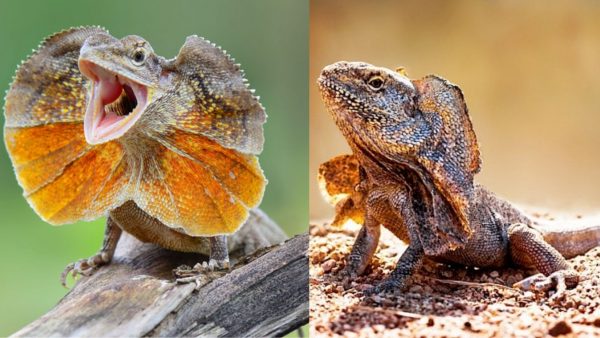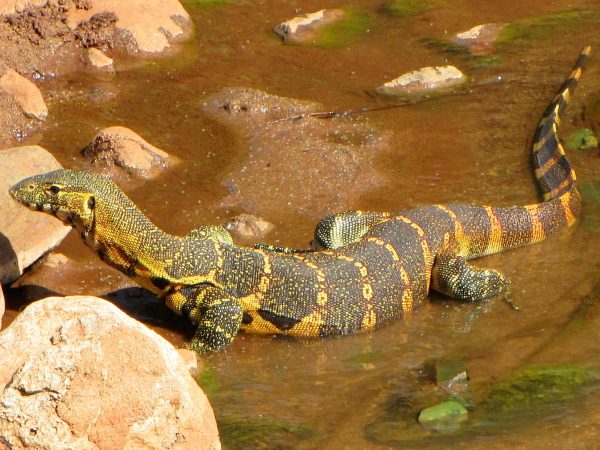Lizards Species:- Lizards are novel pets, but equipping oneself with information before purchase is prudent.
Their price is not great, but acquiring the more costly and proper diet, light, environment is vital in averting often, preventable health problems such as metabolic bone disease.
Preventing potential for salmonella transmission from reptiles and amphibians is also essential.
Some good lizards for beginners are green anoles, bearded dragons, blue-tongued skinks, and leopard geckos. Chameleons, other geckos, iguanas, and savannah monitors add challenge for non-beginners.
Read About
- Top 50 Horse Breeds | Best Riding Horses
- Top 10 Cat Breeds (Cutest)
- Top 10 Cutest Dog Breeds | Most Adorable Dogs (2021)
Top 15 Lizards Species
1. American Water Dragon

American Water Dragons are green in color, and they can be wonderful pets. Of all reptiles, dragons appear to be but the most people-oriented species.
They can play interesting tricks and thus amuse children. They do not attack humans unless the latter exhibit aggression or poor treatment.
In captivity, they require due to amount of heat and water. If you have difficulties with defining ratio, consult your local vet.
2. Anole Lizard

Anole Lizards inhabit tropical and subtropical America, and they are famous for their ability to change colors.
This ability is defined by the pigment cells, which respond to temperature, humidity, and situation.
Anoles are 6-8 inches in length, and they feed on small insects. Females have a distinctive white stripe running down the spine. Anoles are diurnal, and they become active with the rising of the sun.
3. Asian Water Dragon

Water dragons can be found in south-east Asia, the Indo-Australian archipelago, and Australia. Males are larger than females, and they reach 3 feet in length.
They have distinctive crests on the back of the neck, and they are larger in males. They do well in captivity, and they are relatively easy to care for. If you decide to buy one, browse for information and contact your local vet.
4. Bearded Dragon

This dragon lives in the arid lands of central Australia, and it feeds on insects, small vertebrae, worms, as well as on fruits, and flowers.
It has a distinctive beard-shaped pouch, which swells should a dragon be confronted with danger. This gives the dragon a definitely formidable appearance.
Colors vary from tints of brown, gray, and red to bright orange. Bearded dragons mature upon reaching 2 years of age.
5. Blue-Tongued Skink

The Blue-Tongued Skink can be found in grasslands, deserts, and woodlands of Australia.
It is 23.5 inches long, it has small legs and a short tail, which can regenerate. When attacked or threatened, it shoots forth its distinctive blue tongue, swells its body, and warns the enemy by hissing sounds.
Blue-Tongued Skinks are omnivorous, and they live 20 years. They spend nighttime under fallen leaves, logs, and so forth.
6. Chameleon

Chameleons are but the most lovable reptile pets, and they require thorough care and lifelong commitment on the part of their owners.
They live around 8-10 years, and improper feeding can result in various infectious and metabolic diseases, which can be fatal.
Chameleons possess a very kind temperament, and therefore, they are perfect companions for children. Before buying a Chameleon, learn as much as possible about its nutrition, care, and health.
7. Collard Lizard

Collard Lizard is noted for its upright running on the hind legs, but such behavior is rarely seen in captivity, as usually, the enclosures of these lizards do not provide enough room for such runs.
Males have brightly colored throats, green bodies, and bright yellow heads. Female Collared lizards are gray or fawn.
8. Crevice Spiny-Tailed Lizard

Crevice Spiny-Tailed Lizards belong to the Agamide family, and they are popular among pet lovers all over the world.
However, many species fail to survive transportation, or become stressed in captivity. Therefore, it is recommended to buy captive born lizards. There are several types of Spiny-Tailed Lizards, and they differ in size and behavior.
These lizards use their well-armored tails as defensive weapons when hiding in crevices.
9. Emperor Newt

Emperor Newts got their name because of their crown-like cranial ridges that are thought to be for protection against predation. Adults reach the length of up to 8 inches from snout to tail end.
These newts have dark brown to black, semi-rough bodies with bright orange dorsal ridges, heads, tails, and feet. On both sides of the slight dorsal ridge, these creatures have poison glands.
10. Frilled Dragon Lizard

The Frill-necked Lizard, or Frilled Lizard is also known as the Frilled Dragon. These lizards are called so because of the large ruff of skin lying folded back against the head and neck.
The frill aids in thermoregulation, frightens off predators, attracts females and can also be used as a parachute.
11. Gecko

Gecko is a small to moderately large lizard found in warm climates throughout the world. These lizards are famous for their vocalizations.
They have no eyelids and lick their eyes to clean them. Geckos can climb smooth vertical surfaces and even cross ceilings with ease. Some species of Geckos live in human homes and feed on insect pests.
12. Iguana

Iguanas can be found in Galapagos Islands, and this is one of the most unique types of reptiles.
They bear a close resemblance to lizards, and males can reach 4 feet in length. Land iguanas feature lighter coloring and a little larger size of the body.
Actually, there are many varieties of Iguanas in the islands. Iguanas are extremely vulnerable to predators, because they evolved in the environment with few predators.
13. Leopard Gecko

Leopard Geckos live in Afghanistan, Iran, Pakistan and West India. Adults feature patterns of stripes and mottles.
Juvenile species are ringed yellow and dark brown; they obtain spots in the course of time. There are a few differences between sexes.
Males have somewhat broader heads and more defined pre-anal pores. Leopard Geckos are 8-10 inches in length. The sex of the young is determined by incubation temperature.
14. Nile Monitor Lizard

The Nile Monitor Lizard (Varanus niloticus) is one of the largest species on earth, and it can reach 7 feet in length.
These lizards feed on rodents (rats, mice and so forth,) and in captivity they can be fed well cooked meat, boiled eggs and reptile diets.
Nile Monitor lizards occur in different shades of brown, and they feature large dark spots and a few lighter and smaller ones.
15. Savannah Monitor Lizards

This is a large lizard, and it can reach 1.5 m in length. Its weight averages 5-6 kg. The Savannah Monitor Lizard (Varanus exathematicus) has small scales near cranium and larger abdominal and caudal scales.
These lizards are gray; their tapering double-crested tail featuring alternating brown and yellow strips. The lizard has blue snake-like tongue and powerful front legs with strong claws. This animal is common in African Savannahs.
16. Tokay Geckos

Tokay Geckoes occur in gray with bluish spots, and, like many lizards, they can change color in accordance with the environmental background.
They reach 12 inches in length. Tokay Geckoes are oviparous, and they clutch 2-3 times a year, each clutch counting about 2-3 eggs. They lay eggs in crevices or in covered places.
Geckoes possess a rather unfriendly temperament, and biting a feeding hand is not uncommon to them.